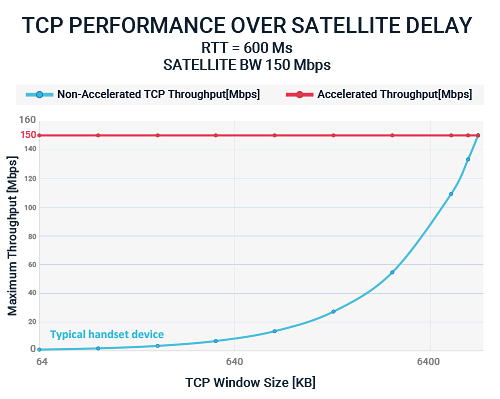Satellite-Based Cellular Backhaul: Myths & Facts
Jointly patented by Gilat and SoftBank, innovative technology enables true high speeds through acceleration of traffic inside the GTP tunnel. This acceleration technique is being used to achieve the required high performance in LTE deployments of Tier-1 mobile networks worldwide, such as Softbank, NTT Docomo and KDDI in Japan; Sprint and T-Mobile in the US; Telstra and Optus in Australia; EE/BT in the UK; and Globe in the Philippines.
Figure 1 below demonstrates the significant benefit of accelerated throughput by showing the actual throughput to the handset achieved over satellite with and without acceleration.
The inherent GEO satellite delay, typically a round-trip of 600ms, causes a severe degradation in performance reversely correlated to the handset window size. The smaller the window size, the lower the throughput. The chart below illustrates how the patented acceleration provides full utilization of the 150Mbps bandwidth for any window-size handset-device. It is important to note that typical handset devices have varying small window sizes and therefore non-accelerated satellite performance would be lower than 10Mbps.

Figure 1 - TCP Performance over Satellite Delay
As the satellite industry evolves to Non-Geostationary Satellite (NGSO) constellations, the satellite latency concern is further mitigated with medium and low orbit satellite (MEO/LEO) due to significantly reducing the satellite distance from the earth.
Myth: Satellite Connectivity is Expensive
In the past, the cost of satellite bandwidth capacity and management of the satellite backhaul often rendered satellite-based communications prohibitively expensive for providers of broadband services.
Fact: Satellite Capacity Pricing Rivals Terrestrial Bandwidth Costs
According to industry analysis and forecasts (see Figure 2), HTS global supply is expected to grow by a factor of 16 by 2025, as many new high throughput satellites, including GEO, LEO and MEO satellites, are launched. At the same time, one can see that the GEO HTS Global demand is significantly less than the supply. In the past few



















